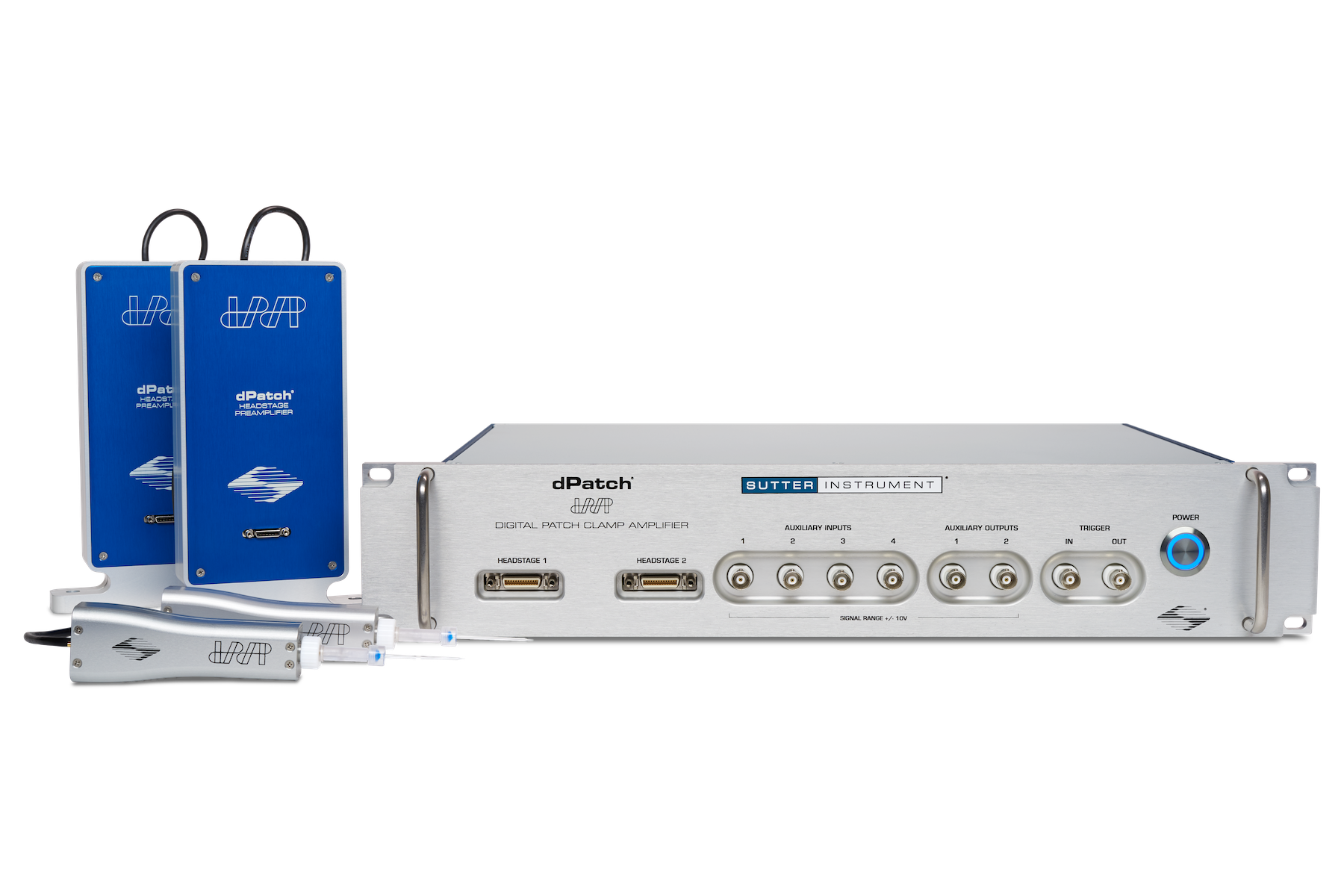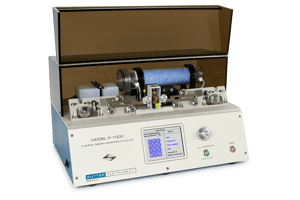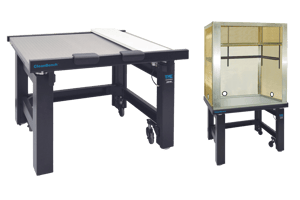dPatch®
While the dPatch System is ready for cutting-edge research, its feature set makes it immediately valuable in any lab setting.
The dPatch amplifier system was built around a simple idea: What if we built a clean-sheet design that used the latest technology to make the next generation of patch clamp amplifiers? We hired the best hardware and software designers available in the industry, the same engineers who created the leading amplifiers already in the market. We asked them to design the best amplifier system possible, using the very latest in digital architecture, and pair it with a contemporary, easy-to-use, yet powerful software platform.
The resulting design represents a complete rethinking of how to best reduce noise and preserve signal to get the cleanest recordings possible, at a bandwidth that far exceeds anything else on the market. The dPatch amplifier system's digital architecture uses state-of-the-art methods in signal processing, such as field-programmable gate arrays (FPGAs) and Arm Core processors – technologies unavailable when the leading amplifiers in the market were designed well over 20 years ago. The processing power of this design FINALLY enables fully integrated dynamic clamp, as well as digital capacitance and resistance compensation. The included SutterPatch® Software facilitates data acquisition, mangement and analysis with an intuitive and easy to learn interface.
Available in either a single- or dual-headstage configuration, the dPatch amplifier system’s architecture makes swapping headstages, or adding a second one to a single-headstage unit, a plug-and-play operation. The two headstages are independently configurable for either voltage clamp or FastFollower™ current clamp.

- Features
- Capability Highlights
- Specifications
- Product Information
- FAQs
- Part #
- Free technical support
- Fully integrated single- or dual-headstage patch clamp amplifier and data acquisition system ensures quick and easy setup
- Optimized for single-channel and whole-cell patch clamp recordings in tissue slices, adherent or dissociated cells
- Full computer control provides automated compensation of electrode and whole cell capacitance
- Voltage clamp, FastFollower™ current clamp and fully integrated dynamic clamp capability for complete characterization of cells' electrical activity
- Line frequency reduction in SutterPatch
- Software lock-in amplifier in SutterPatch for high-resolution capacitance measurements
- Ultra-High bandwidth enables characterization of the fastest signals
- Three headstage feedback ranges for single-channel and whole-cell patch clamp recordings
- Comprehensive digital compensation circuitry provides the utmost precision and signal fidelity
- Bundled SutterPatch® software provides versatile data management, intuitive navigation and streamlined data analysis.
- Automated compensation of electrode and whole-cell capacitance
- Series resistance compensation
- High dynamic range of digitizer means no need for variable gain stages
- High speed of digitizer means no concern about sample rate
5 MHz SAMPLING RATE, UP TO 22-BIT RESOLUTION
One unique feature with dPatch is the headstage data sampling system. Each headstage is continually sampled at 5 MHz. Output filtering has thirteen settings between 100 Hz and 1 MHz. A resolution of 18 bits is achieved at 1 MHz. For lower filter settings, automatic downsampling increases resolution while optimizing data rates. At a bandwidth setting of 1 kHz, the dPatch system provides a signal resolution of better than 22 bits.NO ACTIVE COOLING REQUIRED
Active cooling causes numerous problems that actually create more "noise" in the long run. Active cooling in amplifier headstages use Peltier cells, which cool the electronics for slightly better performance, but generate considerable heat on the opposite side of the cell. The heat generated causes thermal drift which makes it almost impossible to stay patched while doing single-channel work. This is THE MOST COMMON source of what users perceive as "manipulator drift". As a company that makes micromanipulators, we are highly sensitive to the performance of the system within a complete electrophysiology rig.Active cooling can help get a slightly better noise specification on paper, but in the real world the disadvantages far outweigh the slight gain in specsmanship. One of the development goals of the dPatch headstage was achieving a comparable noise performance at room temperature, without the need for a cooled headstage. In the two resistive feedback modes, the dPatch amplifier is even quieter than any of the competitor systems. In addition, the limited life expectancy of Peltier elements causes reliability concerns that we found unacceptable.
BUILT-IN DATA ACQUISITION SYSTEM MEANS NO THIRD-PARTY COMPUTER INTERFACE
Using a multiplexer-free design, the dPatch provides 8 fully differential analog input channels, 4 analog output channels, and 16 digital outputs (TTL). All I/O channels are sampled continuously (200 kHz for analog inputs, 250 kHz for analog and digital outputs) and available through the user interface.SUTTERPATCH SOFTWARE
The dPatch amplifier system, in combination with SutterPatch software, has been engineered to automatically capture and store all amplifier settings, stimulus information and external experiment parameters, and associate them in time with the raw data traces. This includes all amplifier and acquisition settings, as well as timing and progress of the experiment. Fully integrated computer control of the amplifier stages means that the acquisition software is aware of the internal state of the amplifier and digitizer at all times and can track any changes that may occur. This is independent of whether a change is triggered automatically or initiated by the user.DYNAMIC CLAMP
The patented digital architecture of the dPatch amplifier system provides an ideal platform for dynamic clamp. The dPatch is powered by a system-on-chip which provides parallel processing across a Field Programmable Gate Array (FPGA) and two high-speed ARM core processors. Several sophisticated dynamic clamp models are implemented within this architecture. In each model, the update of the applied current values occurs without communication between the dPatch and a computer. Depending upon the complexity of the model, update rates of up to 500 kHz can be achieved. (read more on the SutterPatch Software page)TRACKING OF OTHER EXTERNAL DATA
In addition to status changes in connected hardware that are automatically tracked, the researcher can manually trigger tags to document events like stimulus application using instruments not connected to the amplifier. Information about environmental parameters and a more detailed specification of sample properties can be recorded and stored with the raw data. A total of over 650 metadata attributes are supported. Examples include: animal species, genotype, date/time when a cell sample was prepared, recording solutions, pipette resistance, hardware properties, and detailed information about stimuli applied.
DATA VISUALIZATION AND ANALYSIS
SutterPatch software has been designed to simplify the navigation and analysis of complex datasets. The scope window supports multiple view modes in both two-dimensional and an innovative three-dimensional display. The 3D view is particularly useful during assay development. Built on top of the latest version of the proven Igor Pro platform, SutterPatch combines native Igor Pro functionality with a wealth of features that are tailored to electrophysiology applications. Both the newcomer and the experienced user of patch clamp programs will feel comfortable using SutterPatch software.Application modules provide focused functionality for particular applications.
Currently available:
- Synaptic Event Detection Module: A deconvolution algorithm that excels at detecting miniature synaptic events on a noisy background.
- Action Potential Analysis Module: Phase plane plot, timing and waveform statistics.
- Camera Module: An easy way to document the identity and condition of the recorded cell.
Dimensions
dPatch:
19 in x 11 in x 3.5 in | 48.2 cm x 28 cm x 9 cm
dPatch Preamplifier:
7.6 in x 3.5 in x 1.2 in | 19.5 cm x 9 cm x 3 cm
dPatch Headstage:
3.7 in x 1.1 in x 0.66 in | 9.5 cm x 2.9 cm x 1.7 cm
Weight
dPatch: 15 lbs | 6.8 kg
Electrical
110/240 Volts
50/60 Hertz power line
*Patent No. US 10,393,727 B2
RoHS Compliant
dPatch CE Certificate
![]()



USER MANUAL
dPatch & SutterPatch Quick Start Guide
dPatch & SutterPatch Operation Manual
PRODUCT INFORMATION
Comparison with Brand aX
Dynamic Clamp Flyer
dPatch Sales Flyer (English version)
SutterPatch® Sales Flyer
Comparison of Sutter Amplifier Systems
VIDEOS:
WEBINAR: Dynamic Clamp and Cross-Experiment Analysis
SutterPatch Informational Video
SutterPatch Walk-Through: #1 Introduction
SutterPatch Walk-Through: #2 Amplifier Control
SutterPatch Walk-Through: #3 Routines
SutterPatch Walk-Through: #4 Data Navigator and Metadata
SutterPatch Walk-Through: #5 Application Modules
SCIENTIFIC PUBLICATIONS
Experiments of interest involving Sutter Instrument amplifier systems and SutterPatch® software
Book Chapter: Patch Clamp Technology in the Twenty-First Century
In: Dallas M., Bell D. (eds) Patch Clamp Electrophysiology. Methods in Molecular Biology, vol 2188. Humana, New York, NY
Q: How does dPatch compare to other amplifiers on the market?
A: The dPatch uses current state-of-the-art digital architecture. By converting the signal from analog to digital out near the headstage, we preserve the signal integrity as much as is possible. Almost every noise specification of the dPatch exceeds those of all other amplifiers on the market. In addition, the dPatch constitutes a complete patch clamp system, all data acquisition hardware and software are included, and no external hardware is required for dynamic clamp (see our comparison sheet).
Q: Why doesn't the dPatch have active cooling?
A: Active cooling causes numerous problems that actually create more "noise" in the long run. The heat generated by Peltier cells cause thermal drift in manipulators, making it almost impossible to stay patched while doing single-channel work. As a company that makes micromanipulators, we are highly sensitive to the performance of the system within a complete electrophysiology rig. Active cooling can help get a slightly better noise specification on paper, but in the real world the disadvantages far outweigh the slight gain in specsmanship (see our comparison sheet). In addition, the limited life expectancy of Peltier elements causes reliability concerns that we found unacceptable.
Q: Do I need to buy a digitizer or software with the dPatch?
A: No, because the dPatch is inherently a digital design, no additional digitizer is necessary. SutterPatch software and a license for IgorPro are included with every dPatch system. The dPatch includes everything you need to start running experiments.
Q: Can I retrofit a second headstage to my single-headstage dPatch system later?
A: Yes, dPatch headstage/preamplifier units are interchangeable and self-contained. All calibration and tuning information is stored directly in the headstage/preamplifier unit and read during startup. That makes adding a second headstage easy.
Q: Do the headstages fit on my existing micromanipulator?
A: All Sutter Instrument headstages come with a standard dovetail fitting. This fitting was jointly introduced by Sutter Instrument and Axon Instruments almost 30 years ago and has since been adopted by most manufacturers of patch clamp amplifiers and micromanipulators. That makes Sutter headstages a drop-in replacement on an existing rig, in most cases without even requiring any adjustment.
International prices vary by country. Please contact your local distributor or Sutter Instrument for a quotation.
| Part Number | Description | |
|---|---|---|
| DPATCH | Includes: dPatch system with one headstage and preamplifier, EH-P170 pipette holder, model cell, screw terminal for digital outputs, rack mounting hardware; SutterPatch® software suite with Igor Pro® license | |
| DPATCH-2 | Includes: dPatch system with two headstages and preamplifiers, two EH-P170 pipette holders, two model cells, screw terminals for digital outputs, rack mounting hardware; SutterPatch® software suite with Igor Pro license |
ACCESSORIES
| Part Number | Description | |
|---|---|---|
| IGOR PRO UPGRADE | ||
| IGOR-9UP | Upgrade from WaveMetrics Igor Pro version 8 to version 9. Submit the current serial number when ordering (Help > About Igor Pro). For upgrades from older versions, contact Sutter Instrument or WaveMetrics. | |
| DPATCH-PHS | Headstage & Preamp for dPatch Amplifier | |
| DPATCH-PCH | dPatch Expansion panel | |
| PIPETTE HOLDERS | ||
| While polycarbonate is a proven material for patch pipette holders, it undergoes significant thermal expansion. Uneven warming may lead to motion of the pipette tip and is often incorrectly perceived as drift in the micromanipulator. Our new low-drift pipette holders are made from a proprietary polymer with ultra-low thermal coefficent of expansion. These will significantly reduce thermal drift in environments without tight temperature control. | ||
| EH-L170 | Low-drift pipette holder 1.0-1.7 mm O.D. | |
| ACCESSORIES | ||
| GP-17 | Ground point (solid brass tower), accepts banana plugs and clamp wires up to 10 gauge | |
| GP-W10 | Ground wiring kit, 10 assorted cables, 5 alligator clips, assorted clamp rings | |
| RACK-PK | Rack mounting hardware | |
NavePoint Equipment Racks
| Catalog Number | Description |
|---|---|
| RACK-22U | 22U 2-post open frame rack with casters |
| RACK-42U | 42U 2-post open frame rack with casters |
| RACK-CS-8 | 1 U shelf, 8" (210mm) deep with lip. |
| RACK-CS-16 | 2 U shelf 16" (350mm) deep with lip. |
Applications
- Dynamic Clamp
- Single-channel recordings
- Auditory research and other rapidly changing signals
- Tissue slice recordings
- Cultured cell experiments
- Cell line studies from adherent or dispersed cells
- Optogenetics
- Nanopore and nanogap research
Related Products
Enhance capabilities and take your lab to the next level with more products from Sutter Instrument.
Need help finding the right product?
Whether you're looking for a quote, or unsure of which Sutter product best fits your application, our knowledgeable experts can help answer your questions, and customize systems to fit your needs.




